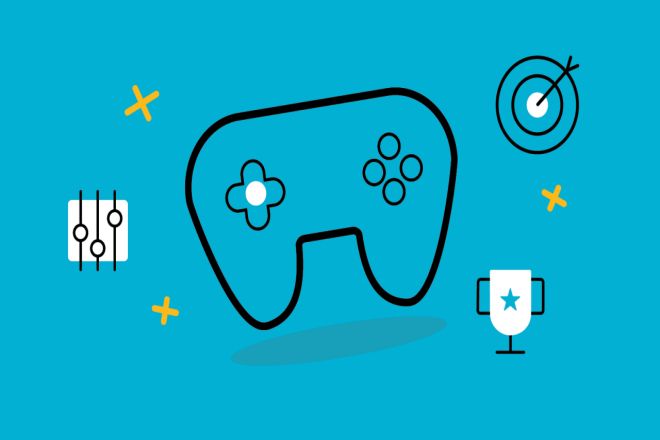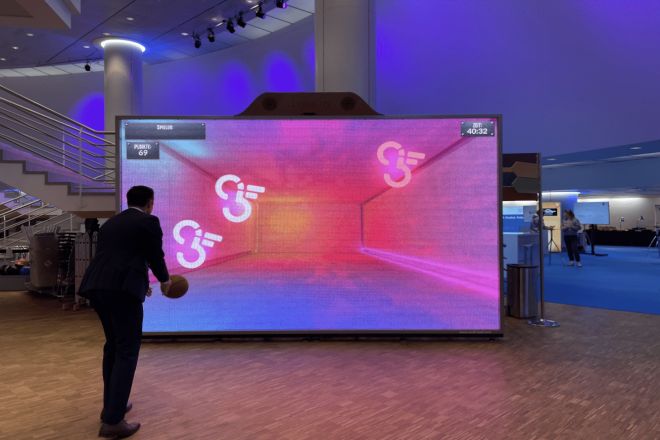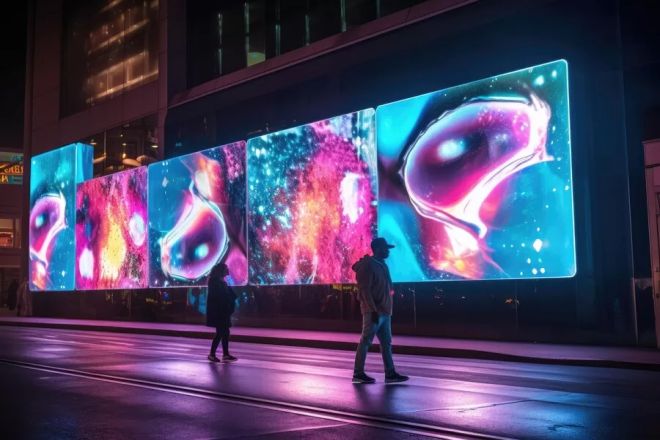مقدمة

In today’s rapidly developing digital entertainment and e-sports, display screens, such as Windows, connecting players to the virtual world, have become key factors in determining game immersion and competitive level.
شاشات عرض LED, with their excellent display effects, high flexibility, and durability, stand out among many display technologies. They are not only widely used in outdoor advertising and live broadcasts of sports events but also gradually occupy a place in the gaming entertainment industry.
However, in the face of the growing needs of gamers, whether LED display screens should have more professional gaming performance has become a question that needs to be answered.
1. What is gaming performance?
Gaming performance refers to the comprehensive performance of a game during operation, which is directly related to the player’s gaming experience. Specifically, gaming performance can include the following aspects:
1). Graphics processing capability
Resolution: The higher the resolution, the clearer the picture, but it also requires higher graphics card performance support. High resolution can provide more delicate picture details, making the game world more realistic.
Frame rate (FPS): FPS refers to the number of screen updates per second, which is an important indicator for measuring the smoothness of the game. High frame rate can reduce screen freezes and tearing, and improve the smoothness and response speed of the game.
Graphics rendering technology: such as ray tracing, HDR (high dynamic range), etc. These technologies can enhance the lighting effects, color performance, and detail level of the game screen and improve the visual effects of the game.
2). System resource usage and optimization
CPU and GPU utilization: The game needs to occupy a certain amount of CPU and GPU resources during operation. Efficient resource utilization can reduce jamming and delays, and improve the stability and smoothness of the game.
Memory usage: Sufficient memory can ensure that the game will not jam or crash due to insufficient memory during operation.
Optimization degree: The degree of optimization of the game by the game development team will also directly affect the performance of the game. Good optimization can reduce resource usage, increase frame rate, reduce delay, etc.
3). Network performance
Latency: Latency refers to the time difference between the player’s operation and the response of the game server. Low latency can ensure that the player’s operation can be quickly fed back, improving the real-time and competitive nature of the game.
Bandwidth: Sufficient bandwidth can ensure the smoothness of game data transmission and reduce jamming and disconnection.
Stability: A stable network connection can reduce interruptions and delay fluctuations during the game and improve the overall performance of the game.
4). Display device performance
Refresh rate: Refresh rate refers to the number of times a display can update the screen per second. A high refresh rate can reduce screen tearing and stuttering, and improve the smoothness and response speed of the game.
Response time: Response time refers to the time difference between the display receiving the signal and displaying the screen. Short response time can reduce the screen ghosting phenomenon, making the game screen clearer and smoother.
Color performance: Good color performance can enhance the realism and visual impact of the game screen.
2. Special requirements of games for LED displays

- Low latency and high refresh rate
In the field of games, players have extremely high requirements for instant feedback on operations and the smoothness of pictures. Low latency means that the time interval between the player inputting the command and the screen displaying the result is extremely short, which is directly related to the player’s operation response speed.
In fast-paced games, such as shooting games or racing games, low latency can ensure that every player’s operation can be quickly fed back, thereby improving the competitiveness and immersion of the game.
On the other hand, gamers also pursue a high refresh rate. Refresh rate refers to the number of times the screen updates the screen per second, usually in Hertz (Hz). Traditional monitors are mostly 60Hz, while high-end gaming monitors generally support 120Hz, 144Hz, or even higher refresh rates.
High refresh rates can significantly reduce screen tearing and stuttering, making the game screen smoother and more natural. In scenes of high-speed movement or fierce fighting, high refresh rates can ensure that players can clearly see every detail so as to make more accurate judgments and reactions.
- Color and contrast
The game scenes are diverse, from dark dungeons to bright outdoor battlefields, from gorgeous magic effects to realistic physical collisions, all of which require the display to have excellent color reproduction and contrast. Color reproduction refers to the ability of the display to accurately present various colors in the game, while contrast refers to the brightness difference between bright and dark parts.
High color reproduction and high contrast can make the game screen more realistic and vivid and enhance the player’s visual experience. Especially in some games that require fine observation, such as puzzle games or strategy games, the accuracy of color and contrast is even more important.
- Resolution and viewing angle
High resolution is essential for the performance of game details. With the continuous advancement of game engines and the increasingly exquisite game screens, high resolution has become a standard configuration for modern games.
High resolution can provide more pixels to present picture details, making the textures, lighting, and special effects in the game more delicate and realistic. This not only improves the visual effects of the game but also allows players to see distant enemies and subtle changes in the scene more clearly.
In addition, wide viewing angle design is also an important feature of gaming displays. Wide viewing angle ensures that players can get consistent color and brightness performance when viewing the screen at different angles, thereby improving the multi-person viewing experience.
In e-sports competitions or home entertainment, a wide viewing angle design allows viewers to watch the game or game screen more comfortably, enhancing overall viewing and interactivity.
- Synchronization and compatibility
Synchronization technologies in game displays (such as NVIDIA’s G-SYNC and AMD’s FreeSync) play an important role in reducing screen tearing and stuttering. These technologies eliminate screen tearing and stuttering by synchronizing the refresh rate of the display with the output frame rate of the graphics card, thereby improving the smoothness and stability of the game.
In addition, the display needs to be compatible with various gaming platforms and devices (such as PCs, game consoles, mobile phones, etc.) so that players can enjoy a consistent gaming experience on different devices.
3. The current situation and challenges of LED display screens in-game applications
1). Current situation analysis
In the current market, the cases of LED display screens in-game applications are becoming increasingly abundant, mainly reflected in the following aspects:
- The giant screen of e-sports venues:
With the rapid development of e-sports, the construction of e-sports venues has also paid more and more attention to the audience’s viewing experience. LED display screens have become the preferred display device for e-sports venues due to their high brightness, high contrast, wide viewing angle, and other characteristics.
In e-sports competitions, LED giant screens can display the game screen in real-time, bringing an immersive viewing experience to the audience. For example, in some large e-sports venues in my country, LED display screens are widely used in the game scene, becoming an important bridge connecting players and audiences.
- LED screens in VR/AR experience:
With the rise of virtual reality (VR) and augmented reality (AR) technology, LED display screens also play an important role in VR/AR experience. By combining LED display screens with VR/AR technology, more realistic virtual scenes and interactive experiences can be created.
For example, in VR games, LED display screens can be used as the background screen of the game world to provide players with a more immersive gaming experience; in AR applications, LED display screens can be used as a platform for information display and interaction.
- External display screen for game consoles:
Although most game consoles currently use traditional LCD TVs or LCD monitors as display devices, high-end gamers have also begun to try to use LED displays to enhance the gaming experience.
The high refresh rate and low latency of LED displays make them more advantageous in gaming competitions. Some high-end LED displays are even equipped with features optimized for gaming, such as G-SYNC or FreeSync synchronization technology.
2) التحديات
Although LED displays have shown great potential in gaming applications, they still face some challenges:
- التكلفة العالية:
The manufacturing cost of LED displays is relatively high, especially for large-size, high-resolution, and high-refresh-rate products. This limits the popularity of LED displays in the gaming field, especially in the personal user market.
- Technical bottleneck:
There are still technical difficulties in further improving the refresh rate and resolution of LED displays. Although some products on the market have achieved high refresh rates and resolutions, a series of technical difficulties still need to be overcome to achieve further improvements.
- Installation and maintenance complexity:
The installation and maintenance of LED displays are relatively complex and require professional technical and equipment support. Especially in application scenarios such as large e-sports venues, the installation and maintenance of LED displays is more arduous and complex.
In addition, since the LED display screen has many pixels, once a fault occurs, it needs to be checked and repaired one by one, which increases the difficulty and cost of maintenance.
- Fierce market competition:
With the continuous expansion of the game market and the continuous advancement of LED display technology, more and more companies are beginning to get involved in this field. The intensification of market competition requires companies to continuously innovate and improve product quality to attract consumers. However, this also brings greater pressure and challenges to small and medium-sized enterprises.
4. Exploring the path to improve gaming performance with LED displays

The exploration of the path of LED display screens in improving game performance can be deeply discussed from three aspects: technological innovation, application scenario segmentation, and ecological cooperation.
1). الابتكار التكنولوجي
1.1). Higher refresh rate driving technology.
- Develop new driver chips:
By developing higher-performance driver chips, high refresh rates of LED display screens can be achieved. High refresh rates can reduce screen delays and improve the smoothness of games, especially in high-speed mobile or fast-paced games. This is particularly important.
- Optimize matrix drive technology:
The use of matrix drive technology can more finely control the brightness and color of LED lights, achieve smoother picture transitions, reduce screen tearing and halo phenomena, and improve the overall quality of game pictures.
1.2). Optimize color management algorithm.
- Quantum dot technology:
Use the high color purity and wide color gamut characteristics of quantum dot materials to improve the color performance of LED display screens. Quantum dot technology can make the color of the picture more vivid and accurate, providing gamers with a more realistic visual experience.
- Color calibration technology:
Through advanced color calibration algorithms, the color of the LED display screen is accurately adjusted to ensure that the game screen can maintain consistent color performance under different light and angles.
2). Application scenario segmentation
2.1). E-sports dedicated screen
- تصميم مخصص:
According to the characteristics of e-sports games, e-sports dedicated LED display screens with ultra-high refresh rate, ultra-low latency, high resolution, and other characteristics are designed. These displays can meet the high requirements of e-sports players for game picture quality and response speed.
- Ergonomic design:
Considering the usage habits and needs of e-sports players, e-sports dedicated screens should also have an ergonomic design, such as adjustable brackets, anti-blue light technology, etc., to reduce the damage to the eyes and body caused by long-term use.
2.1). Home entertainment large-screen
- Extra large size:
The home entertainment’s large screen should be large enough to show the magnificent scenes of the game world and enhance the player’s immersion.
- Smart interconnection:
Support smart interconnection functions such as voice control, smart home linkage, etc., so that players can control games and home devices more conveniently.
3). Ecological cooperation
3.1). Strengthen cooperation with game developers.
- Joint R&D:
Display manufacturers can conduct joint R&D with game developers, optimize the design for specific games, and make the game screen show the best effect on the LED display.
- Shared resources:
Both parties can share technical resources and market resources to jointly promote the advancement of game display technology and market expansion.
3.2). Cooperation with e-sports event organizations
- Event designated display:
Become the designated display supplier for e-sports events and provide high-quality display equipment and technical support for the events.
- Brand exposure:
Through cooperation with e-sports events, enhance brand awareness and influence and attract more potential users.
خاتمة
In summary, LED display plays a vital role in improving game performance. Its unique performance advantages and wide application potential have injected new vitality into the game entertainment industry. In the face of future development trends, we look forward to continuous innovation and breakthroughs in LED display technology to better meet the diversified needs of game players.
At the same time, we also call on the industry to strengthen cooperation and exchanges, jointly promote the development and application of LED display technology, and create a more realistic, smooth, and immersive game world for players.
أخيرًا، إذا كنت تريد معرفة المزيد عن شاشات LED، يرجى الحصول على اتصال معنا.
